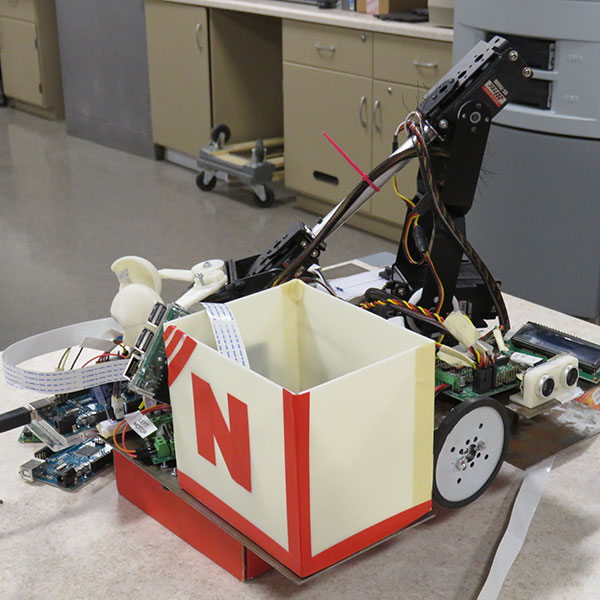Calendar Icon
Jul 27, 2018
Person Bust Icon
By Karl Vogel
![]() RSS
Submit a Story
RSS
Submit a Story

A team of students from four College of Engineering departments will compete against others from around the world in a robotic harvesting competition July 31 at the annual ASABE Annual International Meeting in Detroit, Michigan.
The diversity of engineering majors has been a somewhat intentional by-product of the recruiting strategy, said Santosh Pitla, assistant professor of biological systems engineering.
“You’d think it would be mostly ag engineering students, but it’s purely interdisciplinary,” Pitla said. “We have two agricultural engineering students, from my area, but eight of our 10 students are from mechanical, computer science and electrical engineering.”
Pitla, who specializes in advanced machinery systems, began recruiting students in 2014 to form an agricultural robotics team to compete at the ASABE conference. Pitla pitched his team at the Senior Design Showcase in April and at the university research fairs in the fall and spring and at other poster competitions.
Three years later, in 2017, the Nebraska team took second place in the challenge, which required the robots to “prune” the correct-colored sticks meant to represent branches on a tree or vine.
This year, the challenge is for the robots to harvest ripe fruit from a “tree” filled with ping-pong balls of different colors that represent fruit that is either unripe, ripe or overly ripe. The Nebraska team will be participating in both the advanced and basic competitions.
Because the timing of the ASABE conference conflicts with summer break and numerous internships and work opportunities, Pitla said, only 10 members of the team were available for the competition.
“It’s so hard to keep it going over the summer,” Pitla said. “Now it’s about ‘do I work or do I spend time on the robotics team?’ That’s why I keep telling them that next year we have to finish everything by the time the spring semester ends.”
The growth of the program – it now has 35 members – and its success can be attributed to students realizing how unusual agriculture can be for an engineer and then rising to the challenges, Pitla said.
“Agriculture is a really challenging environment – there’s dust, there’s rain, there’s water. There’s not a factory floor automation, where you can set up your robots in a clean environment,” Pitla said. “There’s a lot of opportunities for research and development. Getting them in the door, once they see it, students get really excited."
And that excitement, Pitla hopes, could carry over into the future careers of the young engineers and could lead to solving some of the world’s biggest problems that aren’t far off on the horizon.
“By 2050, there will be 10 billion people (on earth). How do we get to the point where we can most efficiently create food, fiber and fuel and conserve water? These are all ag-related problems,” Pitla said. “Getting electrical and mechanical engineering students to help solve these problems and work with agricultural engineers is really important for the future. Research or industry careers, all of this will play a role in that.”
Submit a Story